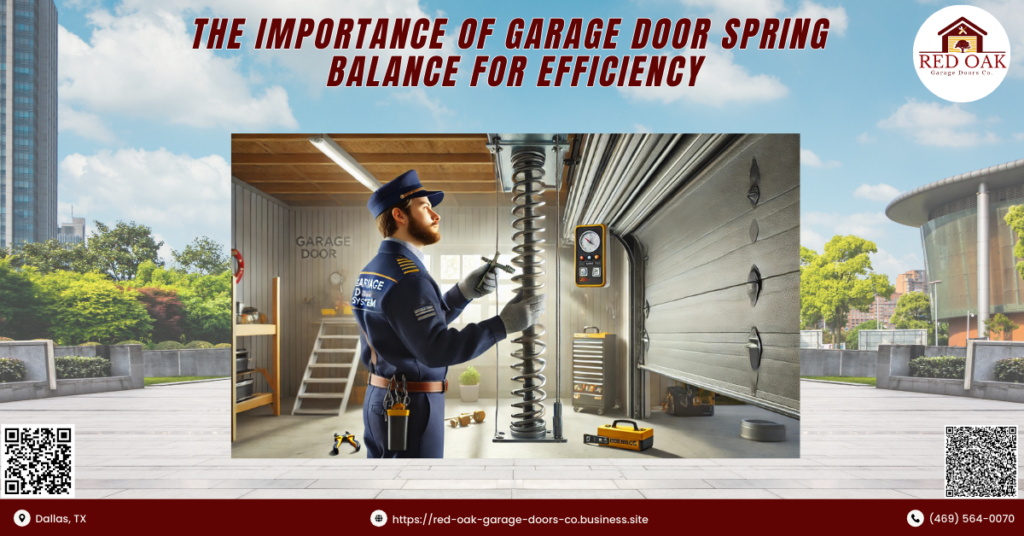Ensure your garage door operates smoothly with balanced springs. Learn why it’s crucial for efficiency and motor longevity. Red Oak Garage Doors Co. – Dallas, TX.

Is Your Garage Door Properly Balanced? Here’s Why It Matters
Imagine this: you’re running late for work, and as you hit the garage door opener, it struggles to lift. According to industry reports, over 70% of garage door failures are related to spring issues, making it a crucial component to maintain. Or worse, it slams shut unexpectedly. Sounds frustrating, right? One of the most overlooked yet crucial aspects of garage door efficiency is spring balance. At Red Oak Garage Doors Co., we specialize in garage door repair in Dallas, TX, and we’re here to help you understand why balanced springs make all the difference.
A well-balanced garage door not only operates smoothly but also reduces strain on other components, including the opener, tracks, and cables. When springs are in optimal condition, your garage door can function effortlessly, providing convenience and peace of mind. Without proper balance, you may experience frequent breakdowns, costly repairs, and potential safety hazards.
How Garage Door Springs Affect Performance
The Role of Springs in Smooth Operation
Your garage door springs do more than just help open and close the door; they counterbalance its weight. Whether you have torsion springs or extension springs, their primary job is to ensure your garage door moves effortlessly with minimal strain on the motor.
Torsion springs, typically mounted above the garage door opening, use torque to lift and lower the door with precision. They provide controlled movement and are known for their durability. Extension springs, on the other hand, are located along the sides of the door and stretch to assist with movement. Both types are critical in ensuring the door’s weight is evenly distributed.
When your springs are properly balanced:
- Your door operates quietly and smoothly, preventing disruptive noises.
- The garage door opener lasts longer due to the reduced strain and effort required to lift the door.
- There’s a lower risk of sudden breakdowns requiring emergency garage door repair.
- It helps prevent misalignment of tracks, cables, and rollers.
An unbalanced garage door can create excessive wear on the opener, potentially leading to repairs that range from $150 to $500, or even total replacement costing upwards of $1,000. Proper spring balance ensures the longevity of your garage door system.
Signs Your Garage Door Springs Are Unbalanced
Not sure if your garage door springs are in good shape? Look out for these signs:
- The door feels heavy or uneven when manually lifted. A properly balanced door should stay in place at any point when manually lifted.
- The door opens or closes too quickly. If your door seems to slam shut or struggle to open, your springs might not be providing the right counterbalance.
- You hear strange noises, like squeaking, popping, or grinding. These noises indicate that the springs are under strain and may need adjustment.
- The garage door motor appears to struggle. If your opener is working harder than usual, it could be compensating for unbalanced springs.
Ignoring these signs can lead to further damage, eventually requiring a full garage door replacement. Don’t wait until your door malfunctions—seek professional garage door spring repair before it’s too late.
Why Balance Matters for Efficiency and Longevity
Protecting Your Garage Door Motor
Your garage door opener is designed to assist with movement, not bear the entire weight of the door. When springs lose their tension, the motor overcompensates, leading to wear and tear that could require frequent garage door opener repair.
Balanced springs allow the opener to function smoothly, reducing wear and extending its lifespan. A well-maintained system helps avoid unexpected breakdowns and ensures you get the most out of your investment.
Energy Efficiency and Safety
Balanced springs not only prolong the life of your system but also enhance safety and energy efficiency. An unbalanced door can waste energy by causing your opener to work harder and consume more power, which can increase your electricity bill over time.
Additionally, an improperly balanced door can pose serious safety risks, such as sudden drops that could injure people or damage vehicles. A garage door that falls unexpectedly can cause injury or damage to property. Regular maintenance ensures safe and efficient operation.
How to Check Your Garage Door Balance
DIY Balance Test (Safety First)
You can perform a simple test to check your garage door balance:
- Disconnect the opener by pulling the emergency release cord to switch to manual mode.
- Manually lift the door halfway and let go.
- If it stays in place, it’s balanced; if it falls or rises, it’s time for a garage door spring repair.
However, for best results, it’s always advisable to consult professionals for accurate diagnosis and adjustments. Attempting to adjust springs yourself can be dangerous due to the high tension they hold.
FAQs About Garage Door Spring Balance
Q: How often should I have my garage door springs checked? A: It’s recommended to have a professional inspection at least once a year to catch potential issues early.
Q: Can I replace garage door springs myself? A: Springs are under high tension and can be dangerous. It’s best to leave it to professionals offering residential garage door repair and commercial garage door repair services.
Q: How long do garage door springs typically last? A: Most springs last around 7-10 years, depending on usage and maintenance. However, heavy use may shorten their lifespan.
Q: What happens if I don’t replace a broken spring? A: A broken spring can lead to complete garage door failure, making it unsafe and inoperable. Immediate replacement is essential.
Protect Your Investment with Professional Service
Ensuring your garage door springs are balanced is vital for smooth operation, energy efficiency, and prolonging the life of your motor. Whether you’re facing minor issues or need an urgent garage door installation, Red Oak Garage Doors Co. is here to help.
From routine maintenance to emergency garage door repair, our expert technicians provide reliable services across Dallas, TX, including areas near famous spots like the Dallas Arboretum, Deep Ellum, and White Rock Lake. Don’t wait until you’re stuck with a malfunctioning door—schedule your garage door spring repair today!
Don’t Miss Out on Special Offers!
Need help with your garage door? Contact Red Oak Garage Doors Co. for expert garage door repair in Dallas, TX. Call us today or visit our website to schedule a service appointment!
